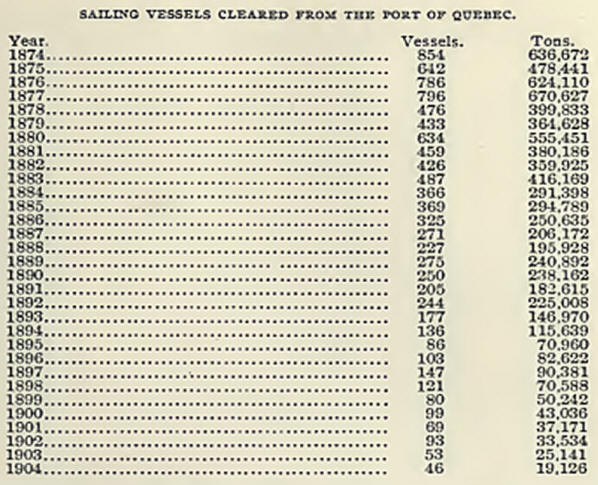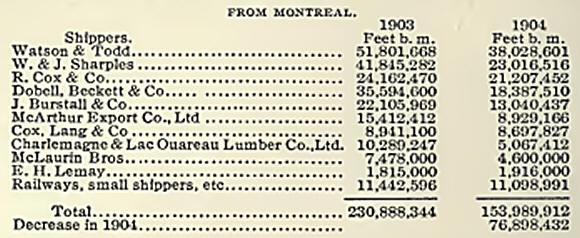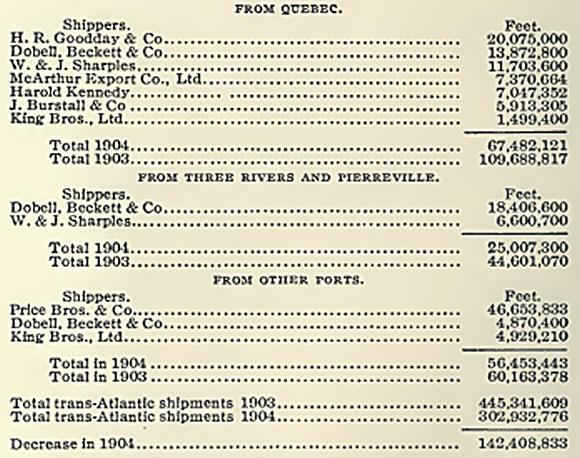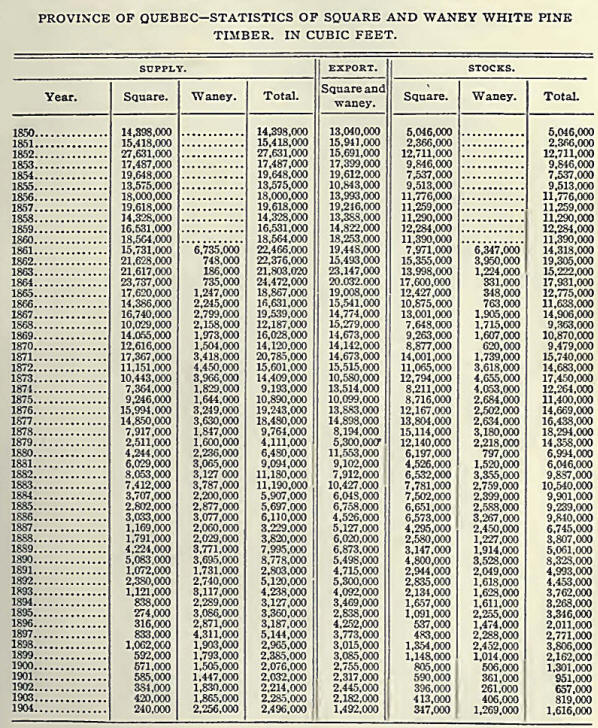|
According to an
estimate published in 1895 by the Dominion statistician, there were
then in Quebec 116,5211 square miles of
forest and woodland. This, however, included a considerable area
unfit for lumbering and covered with a small growth of little
merchantable value. That portion of the Province extending north of
the Ottawa River to the Height of Land, and the districts watered by
the Saguenay, the St. Maurice and their tributaries were originally
covered with forests of great value, with pine their most important
component, though now much depleted by fire and by lumbering
operations— especially in the Saguenay and Lake St. John districts.
North and east of this region there are considerable areas of spruce
suitable for pulpwood. South of the St. Lawrence from the Gaspe
Peninsula to the boundary only small and scattered pine forests
remain. Spruce is the dominant tree, but owing to the demand for
pulpwood the supply is rapidly diminishing. Much hemlock is cut for
tan bark, and maple, birch, cedar and tamarack are largely cut
throughout the Province.
Much of the present
area of Quebec is still largely unexplored. The territory embraced
within the provincial lines prior to 1895 has been largely surveyed
but the additions made as a result of the legislation which then
took place included territory that previously had been designated as
a part of Labrador. The present northern boundary of the Province,
beginning -at the west, follows the East Main River, which empties
into the James Bay, a branch of Hudson Bay, nearly one hundred miles
north of its southern extremity. From the headwaters of the East
Main River at Lake Patamish, just south of the fifty-third degree of
north latitude, it runs due east until it strikes the Hamilton
River, which at that point runs almost due north. The Hamilton River
is followed thence throughout its entire course and through Rigolet
Bay to about the head of Hamilton Inlet, on the Atlantic, from which
the boundary sweeps in a long curve a little east of south to the
Strait of Belle Isle, striking it a short distance west of the
fifty-seventh degree of west longitude. Exploration of the country
north of the Height of Land and of the eastern part, except along
the shore of the Gulf of St. Lawrence, has been confined to the
principal rivers and lakes, many of which have not yet been defined
as to their entire length or exact boundaries.
An enormous field
for lumbering operations has been opened up of late years in the
region made accessible to shipping ports by the Quebec & Lake St.
John railway. In 1904 between twenty-five and thirty sawmills were
in operation in this territory. Of a total of 19,200,000 acres in
the Lake St. John district less than 500,000 are under cultivation
or cleared, and the remainder is all wooded. Of the timber about
seventy-five percent is spruce, and the remainder is made up of
balsam, fir, white birch, cypress and a little pine. Fire has
ravaged the forests in some places, but the effects of fires of
thirty years ago are hardly visible, as there is a fine second
growth.
The pulpwood supply
in this district is very extensive. An official estimate places the
first cut of pulpwood at one hundred million cords, which would give
over sixty-five million tons of pulp. The water power of the
principal outlet of the lake and of several large rivers by which it
is fed is calculated at over 650,000-horse power. Pulp mills have
been established at Chicoutimi and Jonquies on the Saguenay, at
Shawenegan on the St. Maurice and at other points.
TIMBER LICENSES AND
DUES.
The timber lands of
Quebec are leased by the Provincial government to operators, the
right to cut being disposed of by public auction, subject to the
payment of dues on the cut in addition to a yearly ground rent. By
far the larger portion of the lands under license to cut timber in
the Province of Quebec is found between the Quebec & Lake St. John
railway on the east and the Ottawa and the provincial boundary on
the west, and between the Ottawa and St. Lawrence rivers on the
south and the forty-eighth degree of north latitude on the north.
With the exception of a strip of country north of the St. Lawrence
and Ottawa rivers from the City of Quebec to just above the City of
Ottawa and some unlicensed territory in the north, this immense
tract of country, 350 miles long by an average of 125 miles wide, is
all under license. South and north of Lake St. John and the Saguenay
River are also large bodies of land under license, and smaller and
scattering tracts are found all along the north shore of the St.
Lawrence to its mouth opposite the west end of the Island of
Anticosti. The land under timber license extends almost unbroken all
along the provincial boundary from New Hampshire to the Gulf of St.
Lawrence, but the St. Lawrence River shore is open, as is the
country surrounding Quebec and Montreal.
In 1903 there were
64,979 square miles under license, the receipts from which form a
considerable portion of the revenue of the Province. During the year
ended June 30, 1904, $252,554 was realized from sales of limits,
$715,134 from dues, $176,226 from ground rents and $23,563 from fire
tax, transfer fees and other sources, making a total of $1,167,477.
The dues payable on
timber are as follows: Square and waney timber, per cubic foot, oak
and walnut 4 cents, all others 2 cents; sawlogs, boom and dimension
timber, per 1,000 feet b. m., white pine $1.30, red pine 80 cents,
spruce, hemlock, balsam, cypress, cedar, white birch and poplar 65
cents; pulpwood, 65 cents a cord, with a rebate of 25 cents if
manufactured in Canada.
The following is
the cut upon which government dues were paid during the year ended
June 30, 1903: Square timber, hardwood, 150,919 cubic feet; square
pine, 950,451 cubic feet; spruce, hemlock, etc., sawlogs and boom
timber, 377,219,740 feet b. m.; white pine sawlogs and boom timber,
175,072,927 feet b. m.; red pine sawlogs and. boom timber,
33,101,822 feet b. m.; white pine sawlogs eleven inches and under,
69,286,889 feet b. m.; poles, 94,079 lineal feet; pulpwood, 259,231
cords; fire-wood, 1,612| cords; railway ties, 780,960; pickets,
9,174; shingles, 2,424,500; rails, 426; hemlock bark, 23| cords;
lath wood, 31 cords; white birch for spool wood, 11,710 cords, and
posts, 1,255.
THE EXPORT TRADE.
As has been
indicated, the City of Quebec was, until comparatively recent years,
the center of the timber and lumber export trade, but Montreal now
holds that position. This change has been largely coincident with
the growth of the trade in sawn lumber and the decline in square
timber shipments. The first timber shipped from Canada to Europe was
exported under the French regime in 1667. The export to England
began in the early days of the Nineteenth Century when the
continental ports were closed against British trade by Napoleon. The
trade grew rapidly, and when at its height as many as 1,350
square-rigged ships entered the port of Quebec yearly to load
timber. It reached its climax about 1864, in which year 20,032,520
cubic feet of square timber were exported, and since then it has
gradually declined. Formerly, shipments of pine deals were
extensively made from Quebec. In 1880 5,823,263 standards were
shipped, but the bulk of this trade has now gone to Montreal.
The palmy days of
Quebec City as a timber port were also characterized by much
activity in shipbuilding, forty or fifty ships sometimes being built
in a year. At one time the timber trade at this port gave employment
to 5,000 or 6,000 laborers. The timber coves there extended for a
distance of ten miles on both sides of the river. Now hardly a mile
on the Quebec side is so occupied, with but two or three coves
across the river.
The lumber export
trade of Montreal dates back about forty years. It was commenced by
Dobell, Beckett & Co. and has increased from year to year until
Montreal has become the transshipping port for all the pine product
of the Ottawa Valley that is sent over seas. During the season of
navigation the deals are conveyed in barges, carrying an average of
one hundred and forty-five standards each, down the Ottawa River and
the Lachine Canal and transferred directly to the steamer. The
forest product, at one time shipped in the form of square timber, is
now manufactured into deals and boards, and Montreal has become the
leading port of export, as the tendency of modem shipping operations
is for vessels to load at the head of navigation. Montreal is
practically a free port for shipping, and it is frequently the case
that freights are obtainable there on lower terms than in Quebec. In
1879 the lumber shipments from Montreal amounted to 10,499,951 feet;
in 1877, to 32,920,390 feet; in 1888, to 117,329,721 feet; in 1895,
to 175,372,976feet; in 1898, to 335,429,190 feet; in 1900,
to239,686,145 feet, and in 1904, to 153,989,912 feet.
The decrease shown
of late years in these figures is due not to decline in the export
business, but to the route which it takes. Montreal is a summer port
only, as all the St. Lawrence ports are handicapped by ice during
the winter and early summer so that insurance rates are usually
higher from the St. Lawrence than from ports on the open Atlantic.
This has led to a considerable shipment of lumber and other forest
products in bond to Portland, Boston and New York, Portland being
especially favored because it is a terminus of the Grand Trunk
railway; while open Canadian ports, like Halifax, take some of the
business which otherwise would go by vessel from the St. Lawrence.
Much progress, however, has been made in the improvement of
navigation on the St. Lawrence up to Montreal, the channel admitting
vessels drawing thirty feet of water, and while the ice will always
form a hindrance to winter business, the liberal policy of the
Canadian government and the great improvements that have been made
on the St. Lawrence are fast increasing the popularity of that
route, so that it is not improbable that shipments of forest
products from Montreal, and perhaps from Quebec, will in the future
be larger than in the recent past.
The St. Lawrence is
a tidal river as far as Three Rivers, about midway between Quebec
and Montreal. In the original state of the river vessels drawing
eleven to twelve feet of water could under careful pilotage reach
the latter city. Dredging at bars and over shallow stretches so
improved the channel that, as stated above, vessels drawing thirty
feet of water can now dock at Montreal. Until a few years ago,
however, navigation of the river was rather difficult, and was
attempted by vessels of heavy draft only by day. A thorough system
of buoys and channel lights has now made passage unimpeded during
the season of navigation.
In 1868 the
relative values of shipments of forest products were: Quebec,
$6,659,686; Montreal, $631,239. In 1903, the value of forest
products shipped from Quebec was $4,022,346, and of those from
Montreal, $5,121,472. The trade of the former port has revived
somewhat of late years under the stimulus of railway connection with
the Lake St. John district, and other enterprises, but it is hardly
likely to regain its supremacy.
The shipments of
forest products from Montreal for the fiscal year 1903 included pine
deals, $3,147,150; spruce and other deals, $684,070; planks and
boards, $650,008 and pulpwood, $131,152. Those from Quebec City in
the same year comprised pine deals, $122,960; spruce and other
deals, $1,270,325; planks and boards, $68,539; pine (white, square)
$1,297,427; oak (square), $411,313; red pine, $212,634, and elm,
$296,496.
SHIPPING INTERESTS.
It is of interest
to note the decrease in the number of sailing vessels clearing at
Quebec, as the traffic is now almost entirely carried on by steamer.
The following table shows the lumber laden sailing vessels cleared
at the port of Quebec for sea between the opening and close of
navigation in the years 1874 to 1904, inclusive, with their tonnage:

The extent to which
steam tonnage has replaced sail, is shown by the fact that in 1902
the number of steamers entering the port of Quebec for part or
entire cargoes was 186 of an aggregate of 507,097 tons ; in 1903,
185 of 538,672 tons, and in 1904, 165 of 506,702 tons.
The premier
position of Montreal as a St. Lawrence port, due to its being the
head of navigation for ocean-going vessels, is shown by the
following table which gives the number and tonnage of sea-going
vessels entered at that port for the years named:

Quebec is to be
reached by sailing vessels, while Montreal is, for all practical
purposes, available only to steam—and this is the age of steam
navigation.
EXPORTS AND STOCKS.
The most recent
available figures concerning exports from Quebec are those for the
year 1904, and these show a decrease in exports from River St.
Lawrence points to Great Britain in comparison with the year 1903.
The total exportations amounted to 302,932,776 feet, a decrease of
142,408,833 feet from the figures of 445,341,609 feet recorded in
1903. Quebec is a heavy manufacturer of spruce clapboards, and there
was a decided reduction of export of this material, due to the
stagnant condition of the spruce market.
The principal
article of shipment from Montreal is pine in the form of deals and
boards, while other St. Lawrence ports ship principally spruce deals
and square and waney timber. Exports for trans-Atlantic markets
during 1903 and 1904, by ports and shippers, were as follows:

Other St. Lawrence
ports, including the City of Quebec, make the following showing for
1904:

While white pine
and spruce make up the great body of the export of lumber from the
Province of Quebec, other woods, including hardwoods, still figure
in an important way in the trade of the Province. To show the volume
of this business and the conditions surrounding it at the latest
date available for this work, we give the following quotations from
an annual trade circular, issued by J. Bell Forsyth & Co., of
Quebec, bearing date of January 9, 1905:
White Pine.—The
stock of waney pine shows considerable increase in recent years,
while that of square pine is the lightest on record. The continued
advance in price of both waney and square pine has at last told on
the export. As the manufacture this winter will not exceed half the
past season’s supply, and as makers seem unable to reduce their
prices without actual loss, it seems evident present values must be
maintained or manufacture cease.

Red. Pine.—The
smallness of both supply and stock shows the approach of the end of
business in this wood as square timber.

Spruce Deals.—The
export from Quebec and the lower St. Lawrence has been restricted by
absence of demand and the inadequate prices obtainable. The cost of
production has materially increased owing to advanced cost of labor,
enhanced value of limits, and other causes. The demand in the United
States for spruce boards being good at fair prices, the tendency is
for Canadian mills to send their production very largely in that
direction.

Pine Deals.—The
ruling prices in the United Kingdom, especially in the third and
fourth qualities, have materially declined instead of meeting the
ten percent advance paid by shippers for past season’s production.
Ottawa mill owners can readily obtain from United States markets
figures at least equivalent to those paid for deals. It is clear
that export business can not continue under present conditions.

Sawn Lumber.—The
demand from the United States has been good at fair prices, and in
spruce the Canadian mills have cut boards for that market in
preference to deals for export in many instances.
Oak.—The exports
show a marked decrease, and the wintering stock a corresponding
increase. The manufacture of this wood has entirely stopped, and
will not be resumed until justified by demand, as western oak can
not be profitably delivered at Quebec at present current prices.

Elm.—The supply
continues to diminish and price to advance, which will probably be
the case year by year till the wood becomes too expensive for export
or can not be obtained at all. The stock of rock elm is very small,
the figures largely representing soft elm.

Ash.—Will not be
made this winter, as demand seems to have disappeared. The stock is
ample for probable requirements.

Birch.—The export
of this wood continues to diminish from Quebec owing to reduced
supply, the most accessible wood having been cut away, and the less
accessible requiring prices that are not yet obtainable to induce
manufacture.

Through the
courtesy of Messrs. Walcot, Limited, of London, we are able to
present herewith a comparison of the square and waney supply
(equivalent to production), exports and stocks of Quebec each year
from 1850 to 1904, inclusive. There has been a marked change in the'
character of the forest exports sent by Quebec to the mother
country. In the early years shipments of boards from Quebec to
England were almost unknown, the entire export being in the shape of
logs, which were sawed into planks and boards by English sawmills or
part sawed to meet the needs of the purchasers. In 1861 a
distinction became necessary, the history of the development being
thus stated:
Previous to 1861
the timber shipped was square and of large average, beautifully hewn
by the lumbermen in Canada; but board pine—that is, short logs of
large girth—were sent down the drives'with the other timber, and
soon found their way into the market. Being cut from the lower part
of the tree accounted for the waney character of the logs, but the
quality of the timber was excellent. The loss in girthing them for
conversion was considerable, but this was allowed for in the price
to the importer. The decline in the quantity of square and waney
pine made for the Quebec market is altogether due to the increase of
the deal and board trade, and to some extent to the scarcity of
suitable trees to manufacture into timber. A large proportion of the
trees are still suitable to make into deal logs, but would not be
sufficiently large to be made into waney board pine. This is
exemplified by the smallness of the square pine that is now brought
down from Ottawa. In former days square pine used to be made 70 and
80 and even 100 feet cube average; in the present day it is with
difficulty that 40 feet average cube is procurable in square pine,
and waney board pine is decreasing in girth annually. Formerly
20-inch and over average cube was easily procurable; today 17-inch
is as large as most of the manufacturers will undertake, and they
frequently fall below this average on delivery of the timber at
Quebec. These changes are graphically portrayed in the following
table:

|
